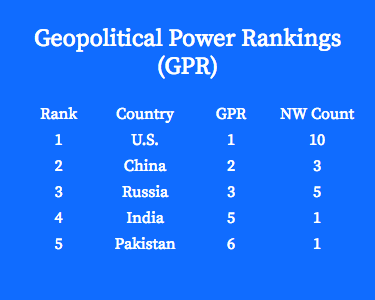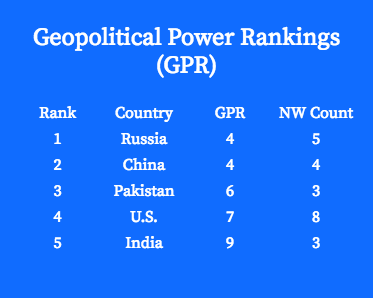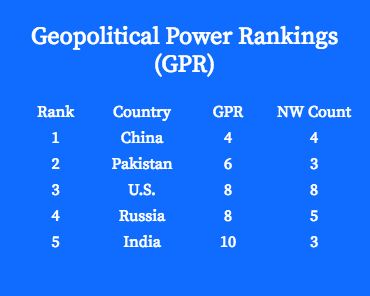Nuclear Diplomacy Simulation Teacher Guide
Although nuclear weapons disarmament is a goal of the 189 countries who signed the Nuclear Non-Proliferation Treaty (NPT), our world is far from being free of nuclear weapons. The purpose of this activity is two-fold: (1) to expose students to the challenges of nuclear weapons disarmament, and (2) to introduce them to a model of a complex real-world situation - in this case, international negotiations towards nuclear disarmament.
Like all models, much of the complexity of reality is stripped away. However, the model used here attempts to retain some facets of geopolitics that mimic problems actually encountered in diplomacy. One important feature is that a few simple rules guiding each country can lead to complex multilateral negotiations.
Audience:
This activity is designed for students in grades 10 and above (including those in introductory college courses).
Guidelines:
The logistics of the simulation are as follows: your class should be divided into five groups, representing five nuclear weapons states: China, India, Pakistan, Russia, and the U.S. Each group should have (either assigned or student-selected) diplomatic liaisons to every other country. For example, if four students represent China, one will be a diplomat to India, another to Pakistan, another to Russia, and another to the U.S. For classes with fewer than 20 students, some students might have to act as diplomats to more than one country, and for larger classes, larger diplomatic teams or additional roles can be introduced.
Each country should receive:
- General Student Instructions, which provide an overview of the rules of the simulation. You should go over this document as a class to make sure that all students understand the rules and metrics that govern the simulation.
- Country-Specific Student Instructions, which inform students of their country’s specific geopolitical goals. Students are free to verbally share content from their Country-Specific Instructions with members of other countries, but the physical document should remain confidential.
- Decision Slips, which allow countries to select the number of Nuclear Weapons they will add or reduce from their arsenals in each round. Each country should receive one slip per round.
To run the simulation, go to classroom.k1project.columbia.edu/diplomacy/play/. This webpage will guide you through the different steps and outcomes of each round. It is recommended that you project it onto a Smart Board while the activity is being played. If that is not technologically feasible, you should copy information from the Geopolitical Power Rankings (GPR) Table onto a blackboard and update it after each round.
At the start of the simulation, the Geopolitical Power Ranking Table will display the values shown in the image below. The Nuclear Weapon (NW) Count values are meant to be a rough reflection of actual nuclear weapons arsenals. Geopolitical Power Ranking (GPR) values reflect whether proliferation decisions are working in a country’s favor. The lower a country’s GPR is, relative to other countries, the more geopolitical power the country is perceived to have.

Like all measures of success or power, it is a matter of perception whether the GPR is of value or not. It is important to present it to the students as a ranking of success, but as with other rankings (e.g. grades, college rankings) it may be an inadequate measure of what is really valuable (e.g. a good education). One of the major impediments to disarmament is that it is always perceived in some quarters to be a sign of national weakness, and countries who disarm in the name of a safer world will have to bear this perception.
The webpage will guide you through different rounds of diplomatic negotiations. Each round represents a real-life period of four years during which country representatives should talk internally and with other groups.
A round of diplomacy should proceed as follows:
1. NW Count Decision Stage:
This stage will take 5-10 minutes during Round 1 as groups first figure out their strategies, and 3-5 minutes for subsequent rounds. You should provide all countries with proliferation Decision Slips so they can circle their decisions and then submit them to you. Your job as a moderator is to encourage countries to negotiate with one another, and remind them that they must decide whether to increase or decrease their NW Counts when the time is over.
Once you have collected the proliferation Decision Slips, you should submit these decisions on the webpage. It is important that you do not begin entering decisions online until you have received Decision Slips from every country.
2. Nuclear Terrorism Attack Stage:
After the NW Count Decision Stage, the website will transition into the Nuclear Terrorism Stage, where you will determine whether a country is the victim of a nuclear terrorist attack. The computer can automatically determine this for you if you select the prompted button on the webpage. However, it might be more engaging for your class if you perform the calculations manually in front of your students. Here are the procedures for (1) deciding if there will be a nuclear terrorism attack and (2) choosing the attacked country:
-
To determine if there will be an attack, refer to the table pictured below to determine what the probability of a nuclear terrorism attack is:
Total NW Count: 0 1-5 6-11 12-18 19-27 >=28 Attack Probability: 0 1/32 1/16 1/8 1/4 1/2 If the odds of an attack are 1/4, flip a coin twice; if it comes up heads both times, there will be an attack. For a 1/8 probability, 3 heads in a row signifies an attack. For a 1/16 probability, 4 heads in a row, etc.
Any result besides all heads means that no attack will occur in this round. If you do roll all heads, then an attack will occur. Proceed to step (2) to determine which country will be the victim.
-
If there is an attack, you must then determine which country will be the victim. This is done by rolling a die and looking at the Geopolitical Power Rankings:
- A roll of 1, 2, or 3 means that the country with the lowest GPR is attacked.
- A roll of 4 or 5 means the country with the second-lowest GPR is attacked.
- A roll of 6 means the country with the third-lowest GPR is attacked.
*Any ties can be broken by rolling the die again, e.g. if a 6 is rolled and two countries are tied for this ranking, then assign 1, 2, or 3 to one of the countries and 4, 5, or 6 to the other and roll again.
You should be aware that nuclear terrorist attacks do not have to be random. As a moderator of the simulation, you can orchestrate or omit an attack at your discretion. After determining whether a country will be attacked, you should enter that information into the webpage. If a country is attacked, select it and press “Attack.” If there is no attack, select “No Attack” to begin the Sanctioning Stage.
Where do these probabilities come from?
The simulation starts at a 1/4 chance of a nuclear terrorist attack, which is based on the “pessimistic” probability estimate of nuclear expert Richard Garwin. (He estimated a 50% chance in ten years, corresponding to a 24% chance in four years.) Since the initial total NW Count is 20, a total NW Count of 20 is associated with a 1/4 probability of a nuclear terrorist attack.
Countries that are perceived to be more powerful are more likely to be attacked because (1) countries regarded as more powerful are more likely to have political enemies and (2) some political theorists have posited that having more nuclear weapon facilities increases the likelihood that a weapon will be stolen because there are more opportunities for theft (Avedon 1997 summarized in Bunn 2006). However, it is important to note that other theorists disagree (Bunn 2006).
3. Sanctioning Stage
After the GPR table has been updated, you should instruct the three most powerful countries (those with the lowest GPRs), to discuss whether to impose sanctions on either or both of the two countries with the highest GPRs. If they decide to sanction a country, select it on the webpage and press “Sanction.” If they decide to not sanction any countries, select “No Sanction.”
If a country is sanctioned, you should remind that country that failure to comply with the requirements of a sanction in the next round will cause that country’s GPR to increase by +2 points. After that, the next round of diplomacy can begin.
It is anticipated that 4-5 rounds of the simulation will be completed in ~45 minutes, though, being open-ended, there is no limit to the number of rounds that can be played. Once you have completed a sufficient number of rounds, press “End Game.” An Activity Log will appear, which contains information summarizing each round of the simulation. This can be printed and used for analysis in your class discussion.
Class Discussion:
Your class discussion should focus on analyzing how accurately the simulation reflected reality. Did the rules for how each country’s GPR was affected by proliferation decisions make sense? How would your students change the model for determining which country suffered the nuclear terrorist attack? How are actual nuclear diplomacy decisions similar to and/or different from the ones your students simulated in the game? Did the simulation offer clues on how to negotiate for disarmament? Did the students learn anything about the dynamics of diplomacy that was not apparent before?
To prepare for this discussion, you might want to read this article that discusses the strengths and limitations of using models to predict international political events (like Iran’s development of a nuclear bomb).
Additionally, it is recommended that you point out the pressures that lead countries to preserve or increase their weapons stockpiles. These include the fear of looking weak by unilaterally reducing stockpiles, the perceived danger in having fewer weapons than regional rivals, and the belief that possessing nuclear weapons will provide freedom from foreign dangers or influence. In the simulation, countries are incentivized to decrease their nuclear stockpiles to reduce the probability that they will suffer a nuclear terrorist attack.
Sample Game:
3 rounds, with terrorist attacks on the U.S. and Russia and sanctions imposed on India:
Round 1
Increases in NW Counts by all countries except China lead to a significant increase in total NW Count.

The GPR table is updated to indicate that the total NW Count is 24.

The probability of a nuclear terror attack occurring with a total NW Count of 24 is ¼. After flipping a coin or using the computer, it is determined that no terrorist attack occurs.

China’s GPR increases since Russia and the U.S. increased their NW Counts but China did not (+1 for each of these).
The U.S., Russia, and China decide to impose sanctions on India, meaning that India must decrease its NW Count in the next round or its GPR will increase.

Round 2
India and Pakistan increase their NW Counts again, as does China, while the U.S. and Russia both decrease theirs.

With the lowest GPR, the U.S. is the most probable target for an attack and is indeed attacked.

India’s GPR increases significantly (+2 for non-compliance of sanctions, +1 for China increasing, and +1 because the sum of Pakistan and China’s NW Counts exceeded the size Russia’s stockpile). The U.S. sees a dramatic increase in its GPR because it suffered a terrorist attack (+4), Pakistan’s NW Count now exceeds two (+1), and China increased its nuclear arsenal while the U.S. did not (+1).

Now India and the U.S. have the two lowest GPRs and thus can be sanctioned, but the most powerful countries decide that no sanctions are imposed.

Round 3
All countries keep their NW Counts unchanged.

Russia is attacked.

Russia sees an increase in its GPR, resulting in Russia having the highest GPR and thus becoming a potential contender for sanctions. Since Pakistan’s NW Count exceeds 2, the U.S. sees another increase in its GPR and now has the same GPR as Russia.

Further Reading:
Nuclear Agreements
- Nuclear Non-Proliferation Treaty
- U.S.-India Civil Nuclear Cooperation Initiative
- New START Treaty (U.S.-Russia)
